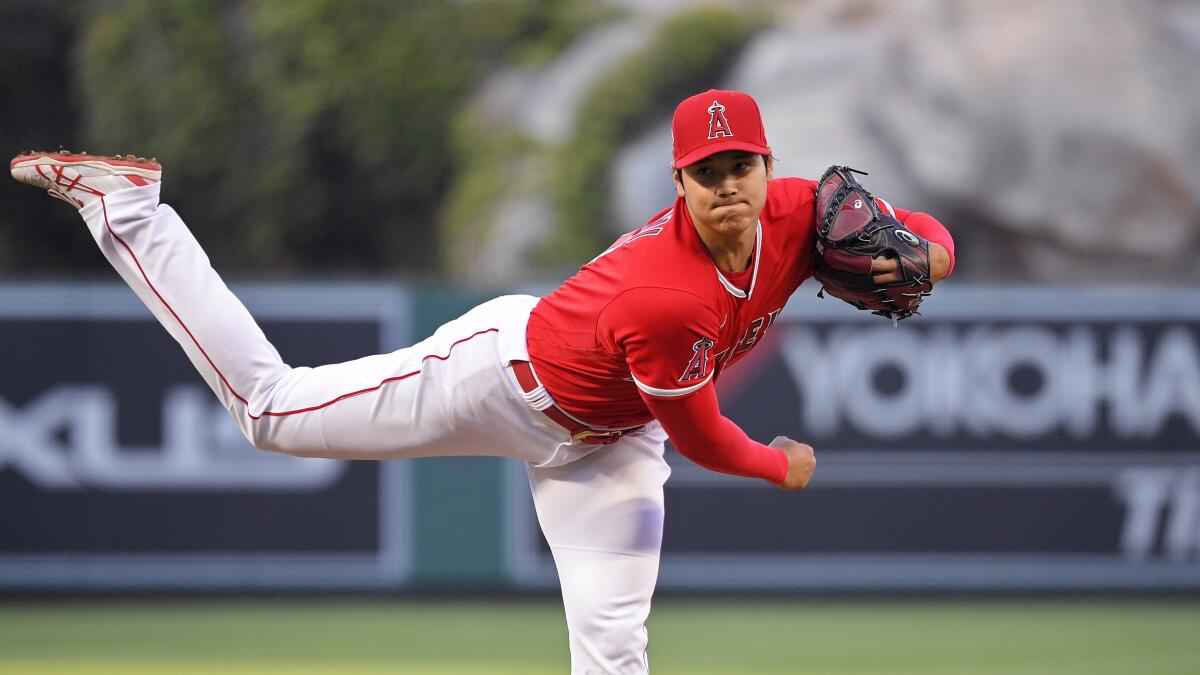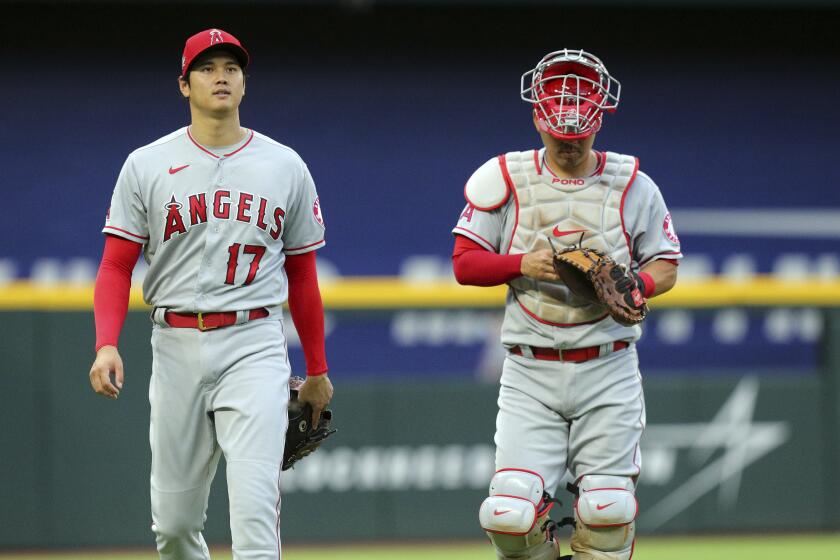Movement, deception, velocity: Why Shohei Ohtani’s splittter has been nearly unhittable

- Share via
For most of the 60-foot path to the plate, it looks like a fastball has come out of Shohei Ohtani’s right hand.
He has the same arm speed, and lets it go from the same release point. It travels on the same plane, appearing to be another upper-90s heater labeled for the strike zone.
Not until the last moment can most hitters realize it’s something else. And by then, they’ve usually already swung, their bat waving helplessly out in front and over the top of a pitch that has dived away from where they thought it was going to be.
When Ohtani throws his splitter, this is the most common result. And a month into this season, Ohtani’s first in a full-time two-way role for the Angels since 2018, it’s again considered one of the best pitches in baseball.
“It’s a pretty dynamic pitch,” Angels manager Joe Maddon said. “It’s hard and it goes straight down. Some really good hitters have some really bad reactions to it. The hitters will tell you how good the pitch is.”
Indeed, entering Ohtani’s fourth start of the season Wednesday night against the Tampa Bay Rays, opposing batters were 0 for 19 against him in plate appearances that ended with a splitter, including 18 retired via strikeout.
“If he gets to two strikes, it’s a really uncomfortable at-bat for anybody.”
— Angels manager Joe Maddon
Of the 23 times opponents have swung at Ohtani’s splitter this season, 17 came up empty — a major league-best 73.9% whiff rate. Of the six times contact was made, five were foul balls. And on the lone occasion the pitch was put in play by the Chicago White Sox’s Leury García, it resulted in a ground ball hit so weakly to second that García was able to beat out a double play.
One hitter has reached base in a plate appearance that ended with a splitter, when the White Sox’s José Abreu drew a walk in that same April 4 game.
Other than that, the pitch has produced virtually flawless results.
“If he gets to two strikes,” Maddon said, “it’s a really uncomfortable at-bat for anybody.”
Ohtani, 26, has other weapons on the mound. His fastball is averaging 97 mph this season, 13th-hardest among qualified MLB pitchers. His slider and curveball have also yet to result in a hit. He has added a cutter this season as well, another complementary option that catcher Kurt Suzuki said adds “a different dimension” to Ohtani’s arsenal.
Angels manager Joe Maddon says Kurt Suzuki’s behind-the-scenes work has helped the 15-year veteran win instant credibility with Shohei Ohtani and others.
But the splitter is his trademark pitch, earning admirers inside the Angels clubhouse and elsewhere around the sport.
“If he has command with his fastball, they have no chance laying off of his split,” said Hall of Fame pitcher John Smoltz, who has followed Ohtani closely as an analyst for MLB Network. “Because he comes out of the same slot, and it comes out firm in the middle of the zone, it drops and it has great late movement.”
Smoltz added: “Trying to catch up with velocity and then distinguish between fastball and split differential, it’s just ridiculous. It comes out of his hand the same way.”
The splitter was a key pitch for Smoltz, another hard-throwing right-hander, during a 21-year MLB career spent mostly with the Atlanta Braves. Originally, he developed it to use specifically against left-handed slugger Barry Bonds, whom Smoltz and the Braves met in the playoffs in 1991 and 1992. The first year Smoltz incorporated the splitter full-time in 1996, he won the Cy Young Award and led the majors in strikeouts.
“It was a pitch that came real easy to me,” Smoltz said. “I threw that pitch just like a fastball with no stress whatsoever. And the ball just disappeared, went completely left-to-right. You want to talk about a new tool, having fun for the first time against power left-handed hitters, that was a game-changer for me.”
“Trying to catch up with velocity and then distinguish between fastball and split differential, it’s just ridiculous. It comes out of his hand the same way.”
— Hall of Fame pitcher John Smoltz
The splitter’s prevalence in the sport has slowly faded over the years, largely because of concerns about the strain it puts on a pitcher’s arm. Even Smoltz stopped throwing it later in his career. This season, of the almost 500 big leaguers who have thrown at least 50 pitches, only 31 have used a splitter.
But in Ohtani’s case, it serves as an effective complement to his other pitches, with sharp downward movement that differentiates from his high-velocity fastball and slight left-to-right tailing action that breaks the opposite direction of his slider.
“Obviously when you’re throwing the ball in the upper 90s, low 100s, and then you throw the same arm speed on something that comes out about 10-12 mph slower, it’s gonna throw a hitter off,” said Suzuki, who has been Ohtani’s primary catcher this season.
Ohtani is at his best, of course, when he’s consistently commanding those other pitches too, something that has been a work in progress this season (his 21% walk rate is fourth-highest among pitchers with at least 10 innings).
But when Ohtani does get ahead, when he does put hitters on the defensive, he can turn to one of the best putaway weapons in the sport — separating his index and middle fingers over the seams, and unleashing a pitch that so far opponents have barely been able to touch.
“It’s a fantastic pitch,” Smoltz said. “It’s just such a weapon with the velocity he has.”
More to Read
Go beyond the scoreboard
Get the latest on L.A.'s teams in the daily Sports Report newsletter.
You may occasionally receive promotional content from the Los Angeles Times.








